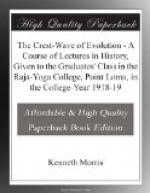So in England, Wordsworth opened this last cycle of poetry; coming when there was a clear atmosphere, and speaking more or less clearly through it his message from the Gods. You hear a like radiant note of hope in Shelley; and something of it in Keats, who stood on the line that divides the Poet-Prophet from the Poet-Artist. Then you come to the ascendency of Tennyson, whose business in life was to be the latter. He tried the role of prophet; he lived up to the highest he could: strove towards the light much more gallantly than did Sophocles, his Athenian paradigm. But the atmosphere of his age made him something of a failure at it: no clear light was there for him to find, such as could manifest through poetry. Then you got men like Matthew Arnold with his cry of despair, and William Morris with his longing for escape; then the influence of Realism. So many poets recently have an element of Euripides in them; a will to do well, but a despair of the light; a tendency to question everything, but little power to find answers to their questions. Then there were some few who, influenced (consciously or not) by H.P. Blavatsky, that great dawn-herald, caught glimpses of the splendor of a dawn—which yet we wait for.
Euripides, with the Soul stirring within and behind him, “broke himself on the bars of life and poetry,” as Professor Murray says. He was so hemmed in by the emanations of the time that he could never clearly enunciate the Soul. Not, at any rate, in an unmixed way, and with his whole energies. Perhaps his favorite device of a Deus ex Machina—like Hercultes in the Alcestis —is a symbolical enunciation of it, and intended so to be. Perhaps the cause of the unrest he makes us feel is this: he knew that the highest artistic method was the old Aeschylean symbolic one, and tried to use it; but at the same time was compelled by the gross emanations of the age, which he was not quite strong enough to rise above, to treat his matter not symbolically, but realistically. He could not help saying: “Here is the epos you Athenians want me to treat,—that my artist soul forces me to treat; here are the ideas that make up your conventional religion;—now look at them!” And forth-with he showed them, in there exoteric side, sordid, ugly and bloody;— and then, on the top of that showing, tried to twist them round to the symbolic impersonal plane again; and so left a discord not properly solved, an imperfect harmony; a sense of loss rather than gain; of much torn down, and nothing built up to take its place. The truth was that the creative forces had flowed downward until the organs of spiritual vision were no longer open; and poetry and art, the proper vehicles of the higher teaching in any age approximately golden, could no longer act as efficient channels for the light.




